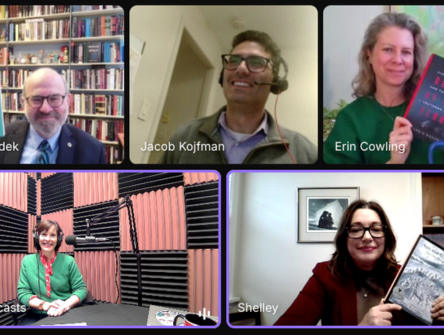‘A huge leap forward for the entire justice system’
With the passage of Bill C-40, the federal government has made it easier to right wrongful convictions

In October, Clarence Woodhouse walked out of a Winnipeg courtroom a free man—five decades late.
Fifty years earlier, he and two other Indigenous men were convicted of murdering a restaurant worker. His two co-accused were acquitted last year. Their convictions were based largely on statements — including one signed confession — given to police who were fluent in English.
Woodhouse’s first language was Salteaux, and he spoke little English. He was not provided with an interpreter during his trial.
Woodhouse, 72, spent 12 years behind bars before being released on parole. After his conviction was quashed, Chief Justice Glenn Joyal apologized to Woodhouse on behalf of the justice system.
“There’s nothing I can say to you that can give you back those 12 years,” he said.
This month, the federal government moved to make it easier to correct such life-altering errors. Bill C-40, which received royal assent on Dec. 17, takes responsibility for reviewing potential wrongful convictions out of the hands of the justice minister and gives it to an independent commission.
The people who have been pushing for this change think it could have a ripple effect on every aspect of the system, from police to courts — provided politics doesn’t get in the way.
“This is a huge leap forward for the entire justice system,” says James Lockyer, partner at Lockyer Zaduk Zeeh and founding director of Innocence Canada, a group that advocates for the wrongfully convicted.
“As more of these miscarriages of justice come to light, it’s going to lead to legal reform, to systemic reform. It’s going to cause everyone involved, at the trial and appellate levels, to look at what they’re doing now and consider changes. Because they will be confronted with how often the appeal system fails people.”
Under the current system, the justice minister makes final decisions about possible wrongful convictions on the advice of a department panel, the Criminal Conviction Review Group (CCRG). The CCRG examines conviction review applications and forwards them to the minister if it thinks something has changed since the trial.
“An application is highly unlikely to succeed if it merely repeats arguments made at a trial or appeal and is not based on new or significant information,” says the Justice Canada website.
In practice, conviction reviews are exceedingly rare. Just 31 reviews of potential wrongful convictions succeeded in Canada between 1982 and 2024. Over a much shorter period, the Criminal Cases Review Commission in Britain — the model for Canada’s new commission — sent more than 800 cases back to the appeal court.
To date, Canadian justice ministers have referred the cases of only 31 people — most of them white men, none of them women.
Sen. Kim Pate, a prominent supporter of C-40, said the old system failed to address the impact of systemic misogyny and racism on women, particularly Indigenous women, whose deep suspicion of the justice system sometimes leads them to take plea deals even when they’re innocent.
“I know of two Indigenous women who had their murder convictions overturned and were given new trials. They were immediately offered guilty pleas to manslaughter by the Crown. They took the pleas,” she says.
“One of them said to me, ‘Can you honestly guarantee me that if I don’t take this plea, I won’t be reconvicted?’ And, of course, I could not.”
C-40 replaces ministerial oversight with a Miscarriage of Justice Review Commission, an independent body of five to nine commissioners tasked with evaluating applications for review, conducting investigations and — if it believes a miscarriage of justice may have occurred — ordering a new trial or sending the case back to the relevant appeal court.
Lockyer thinks the new commission will be extremely busy for a while.
“Based on the experience of commissions in other countries, I think we can expect around 70 applications or more per year for the first few years, but that should slow down, maybe to 20 or 30,” he says.
Some experts wonder whether the new Commission has the resources and personnel it will need to keep up with that workload. Tony Paisana of Peck and Company and a member of the CBA’s criminal justice section, testified on the bill before Commons and Senate committees. He says the government is asking the Commission to do a lot with very little.
“Right now, it’s nine commissioners, only five of whom are full-time,” he says.
“This Commission is going to have a lot of work ahead of it, and if we want to signal that this work is really important, appointing part-time people to do it seems like the wrong approach.”
The legislation itself establishes no baseline level of funding for the Commission. Critics say that could make it vulnerable to future governments with little enthusiasm for its work. Pate points to how previous federal governments shut down the Law Commission of Canada and the fact many provincial legal aid services are underfunded.
“There’s the risk that the next government might not be well disposed to the Commission and its mission,” she says.
“So it’s an open question whether the Commission can expect adequate funding and administrative support.”
Paisana and the CBA argued that the legislation should include a new basis for an appeal — an “unsafe verdict” — which would capture situations where — in the words of Kent Roach at the University of Toronto’s law faculty — “the appeal court can’t identify a specific error in law, but there’s a sense of unease about the conviction.”
“The current standard of appeal is an unreasonable verdict, which sets the bar extraordinarily low for the prosecution,” says Lockyer.
“It’s not a standard that’s designed to catch wrongful convictions. It’s a legal test aimed at answering the question of whether there was a scintilla of evidence at trial to indicate guilt.”
He adds: “Appeal courts need to be able to say, ‘We have our doubts.’ And if they do, they need to be able to quash the convictions.”
Roach points out that the Commission will have no power to review sentencing. It also won’t have statutory access to information “over which claims of solicitor-client privilege might be made.”
“That could turn into a problem down the road,” he says.
“The Commission basically has the powers of a public inquiry, so claims of privilege may arise. The U.K. commission has access to information over which privilege claims can be made, but the Canadian legislation is silent on that point.”
Pate also argues that the Commission should have a guaranteed number of Indigenous and Black commissioners to ensure it understands the “context” of racism that surrounds so many wrongful convictions.
All of these criticisms are legitimate, Lockyer says, but they fail to appreciate how the Commission’s work could have a transformative effect on the justice system by educating the public about how common wrongful convictions really are.
C-40 tasks the Commission with proposing policy changes and publishing annual reports on its work, including demographic data. That, coupled with the publicity generated by conviction reviews, could ramp up pressure for legal reforms that make wrongful convictions less likely.
“People tend to assume that if someone goes through the appeal process, they can’t be wrongfully convicted,” he says.
“But it happens. David Milgaard went through the appeal system and still didn’t receive justice.”


